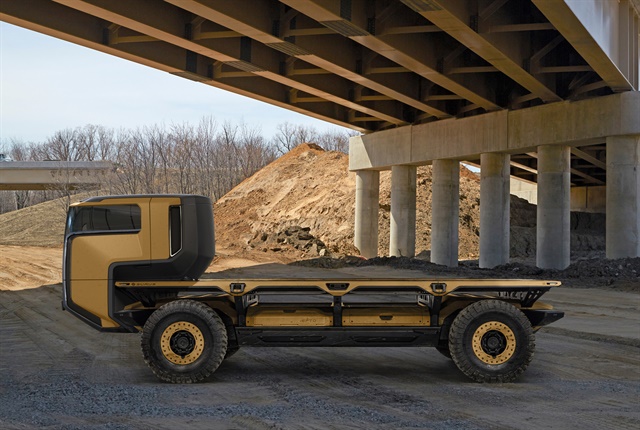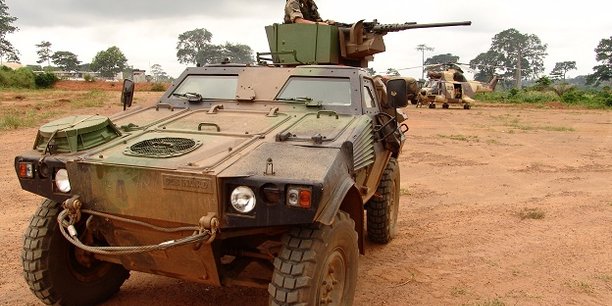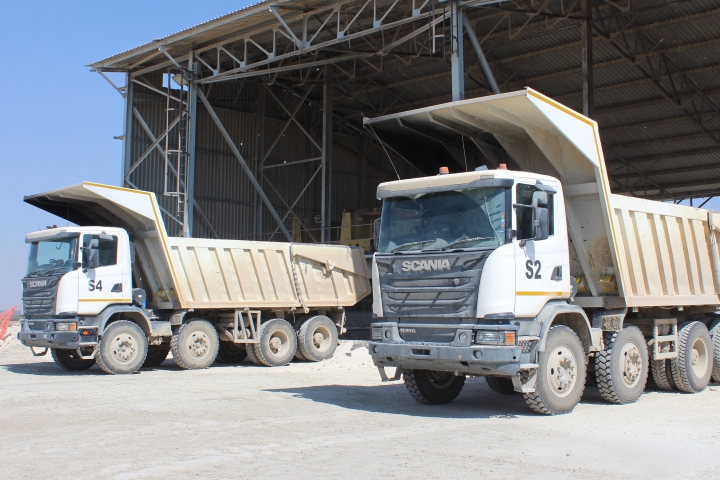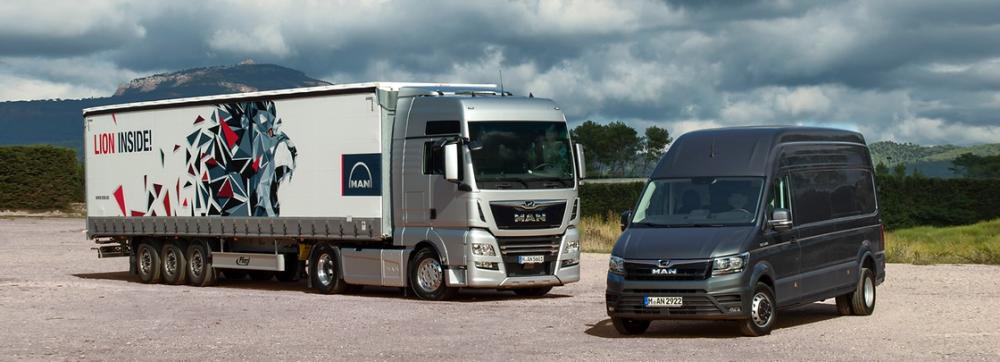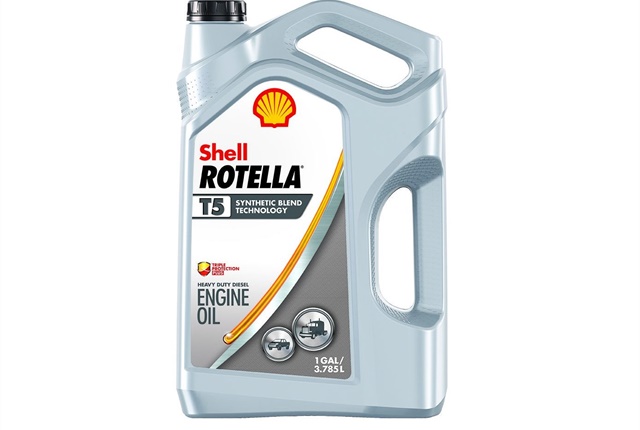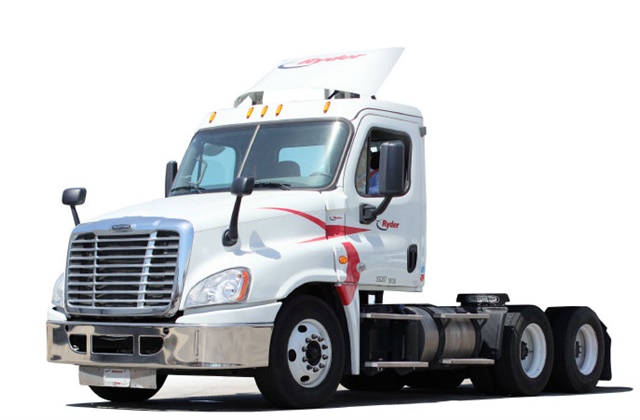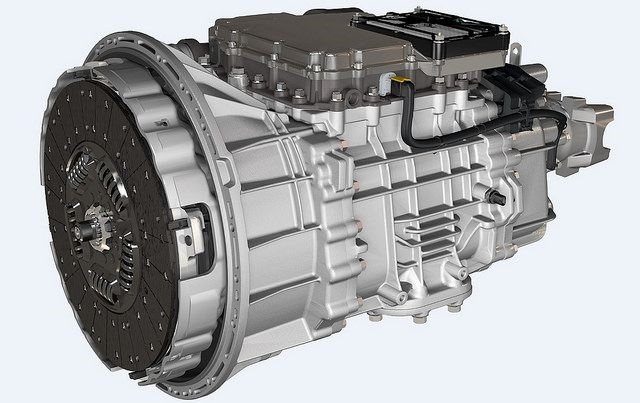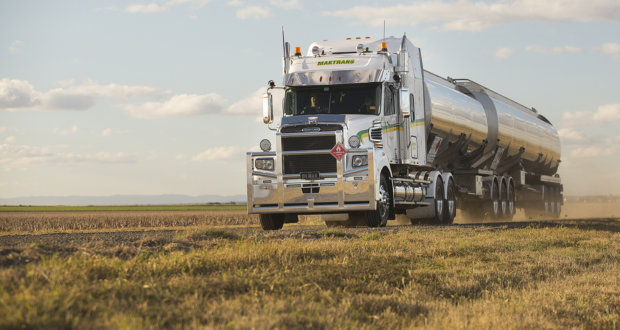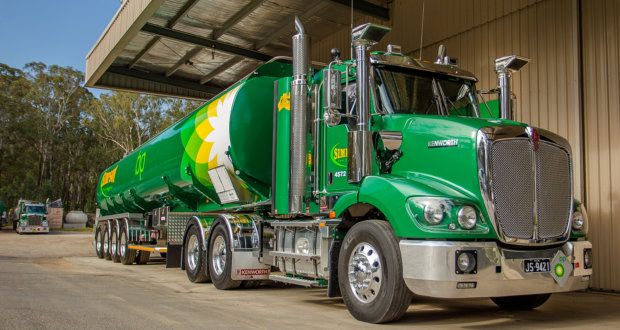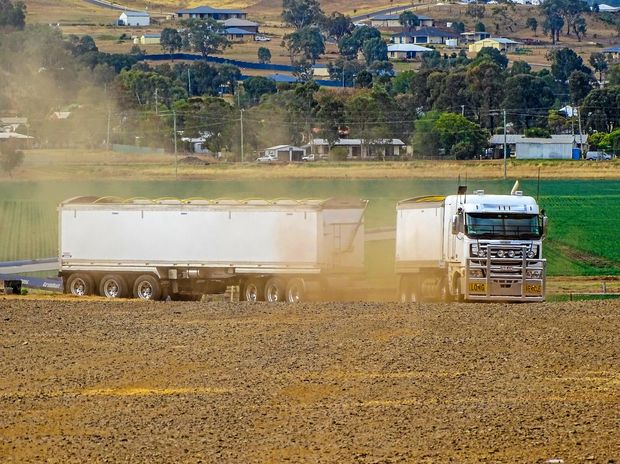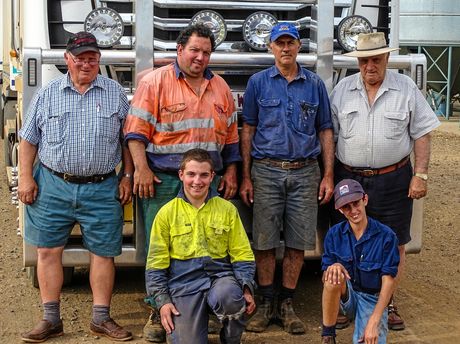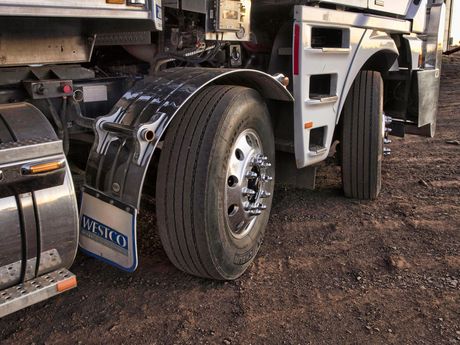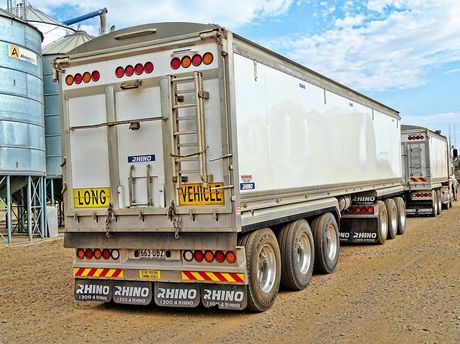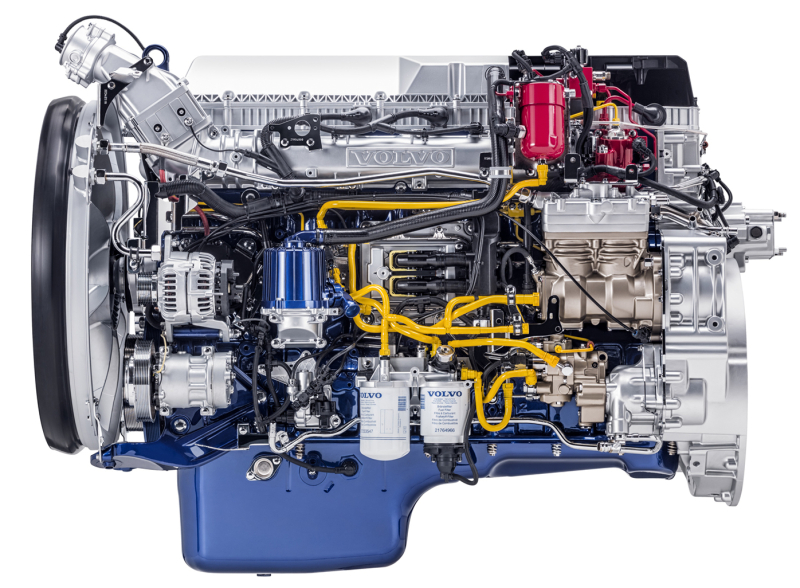
kscarbel2
Moderator-
Posts
17,893 -
Joined
-
Days Won
86
Content Type
Profiles
Forums
Gallery
Events
Blogs
BMT Wiki
Collections
Store
Everything posted by kscarbel2
-
Heavy Duty Trucking (HDT) / October 6, 2017 General Motors has developed a medium-duty chassis cab truck powered by a hydrogen fuel cell powertrain for commercial buyers that the company is also pitching to the U.S. military, the company announced. GM will show the truck, which is known as the Silent Utility Rover Universal Superstructure (SURUS), at the fall meeting of the Association of the United States Army (AUSA) from Oct. 9 to 11. The truck uses GM's Hydrotec fuel cell system and offers autonomous capability, according to GM. It has been developed to handle large payloads over longer distances. The vehicle is a hydrogen-electric hybrid using GM's second-generation fuel cell system, two electric drive units, and lithium-ion battery pack that enables more than 400 miles of range. Commerical applications include use as a utility truck, mobile and emergency backup power generation, flexible cargo delivery systems, commercial freight, and medium-duty uses. The vehicle also uses four-wheel steering, advanced propulsion power electronics, GM truck chassis components, and an advanced suspension. The SURUS commercial platform was developed with the help of research from GM's joint testing project with the U.S. Army of its hydrogen-powered Chevrolet Colorado ZH2. GM will continue testing the SURUS truck through the spring of 2018. .
-
KNDS has finally filed a takeover offer for Renault Trucks Defense La Tribune / October 6, 2017 KNDS has finally filed a takeover offer for Renault Trucks Defense (RTD). Krauss-Maffei Nexter Defense Systems (KNDS) presented an offer to the Swedish Volvo last Friday, the 29th of September. This could finally boost the sales project initiated by the truck manufacturer, who wishes to transfer his activity in defence, made up of Renault Trucks Defense (RTD) – which owns the brands Acmat, Panhard, and Renault Trucks Defense, the American brand Mack Defense and Volvo Defense. The sale has been blocked since the summer, KNDS who have not sent in an admissible tender to Volvo, contrary to the Belgian group CMI. Clearly, the French-German group had not submitted a financial offer. The Swedish group was very embarrassed by the attitude of KNDS. As a result, the timetable has slipped from 30 to 45 days. The selection of the buyer could be decided by Volvo at the end of November, beginning of December, the worst in January. A delirious asking price If KNDS had not yet submitted an offer “admissible”, it had at least two profound reasons. In particular, the price charged by Volvo and its bank board, Rothschild. Volvo was anticipating a sale price of approximately 500 million euros. But Rothschild touted that it could do much better and win a jackpot of 700 million euros. But at the end of the due diligence (opening of accounts), KNDS and CMI was found “delirious” over the business plan devised by Volvo and Rothschild. Also the sales price is considered too high. And this all the more that Volvo has withdrawn from sale the American brand Mack Defense, which had been obtained in 2015, a very important contract in Canada for an amount in excess of € 500 million approximately. The “clipping” of this activity also seems to be very complicated. In addition, Volvo and RTD would not be the owners of the brands Renault Trucks Defense and Panhard (PSA). As for Renault, the French manufacturer would like to see disappear the Renault Trucks Defense (RTD) brand disappear. Thus, according to several sources, CMI would have offered a sum of 400 million euros approximately, while KNDS estimates a selling price between 300 and 400 million euros. A project that divides KNDS At KNDS, the proposed acquisition of RTD in particular, the activities of light armored vehicles would join Nexter in the case of redemption, divides the French and the Germans. If the French attach much importance to this folder, even put the price, the Germans are much more looking. In clear, no question of doing anything, the family Bode-Wegmann (shareholder family of Krauss-Maffei) is not ready to open the financial floodgates. .
-
Scania Group Press Release / October 5, 2017 In 2015 PPC in Slurry, South Africa, decided to replace its fleet of rigid dump trucks with four Scania mining tipper trucks, to transport run-of-mine (crude, ungraded) material to the processing plants. Two years on, the decision is paying substantial dividends, by offering several cost advantages. “To change to Scania, after running rigid dump trucks for over a century, took a complete change of mind-set for us as management, as well as our people,” says Andre Niemand, Technical Advisor at PPC Slurry. PPC’s change of vehicle came as part of a huge upgrade of its production facilities. The company invested more than 100 million euro on the improvements. The brownfield project, which began in 2015, will increase cement production at Slurry from 1.2 million to 1.9 million tonnes a year. To finance such a capital-intensive project, a number of cost-cutting initiatives were identified. Transport – which accounts for a third or more of any mine’s operational costs – is often the biggest variable cost in mining operations. The company started to investigate a possible cost-effective hauling solution. “We needed to look at something else. We decided on a construction-type of a vehicle, but one that would be able to carry larger payloads that we wanted to,” says Niemand. After consultations with the Scania team, PPC Slurry eventually invested in four Scania G 410 mining tippers. Two years on, the range has ticked all the right boxes, from productivity and versatility through to lower fuel consumption and lower service and maintenance costs. “The Scania mining tippers are giving us 28–32 tonnes of payload, depending on how we load,” says Niemand. Massive fuel savings The truck’s lighter body translates into increased payload and lower fuel consumption. Massive fuel savings, as high as 50% compared with the previous range of conventional yellow metal haulers, are being realised at Slurry. The current utilisation of the vehicles is about 83%, which is way more than the 72% global benchmark for the mining industry. Another major advantage is that Scania’s mining tippers offer lower operating and capital costs. Service and wear parts are far cheaper than yellow metal haulers. “We are saving 20% on maintenance costs compared with the conventional range of haulers we used to run,” explains Niemand. From a capital expenditure point of view, gains are also massive. “When we calculated what it would cost us to buy a new conventional tipper and do three rebuilds over its 18-year lifetime, versus buying a Scania tipper and replacing it every three years over the same 18-year period, the figures showed that we would be able to save about 400,000 euro,” says Niemand. “We appreciate the service and support Scania gives us” He is also very happy with the support offered by Scania. “We appreciate the service and support Scania gives us. They attend to any issues that we may have in a timely fashion and they go the extra mile to make things work for us.” The relationship is blossoming: PPC Slurry has since placed an order of three more Scania G410 mining tippers, and is prepared to invest in even more units. “We are definitely going to buy more Scania trucks once the new XT range becomes available,” says Niemand, who is looking at increasing the fleet size to ten units that will be able to put through a total of 1,100 tonnes an hour through the crushers. .
-
Scania Group Press Release / October 6, 2017 The new Scania Heavy Tipper has now been released to mining operators. It is designed to meet the toughest demands of this industry. With more robust components, the payload capacity is 40 [metric] tonnes, one-quarter more compared to the current range. The mining tipper truck has initially been launched in non-European markets and will shortly be adapted to Scania’s new generation trucks. With this new tipper, operational uptime is five percent higher with 5,000 more service life hours – reducing the cost of operation over the product’s life cycle and increasing residual value. “The aim has been to improve operating economy using all the experience gained from our lean production system to mining. We can thereby combine our vehicle offering with optimised transport solutions to meet the needs of each customer,” says Björn Winblad, Head of Scania Mining. The 6×4 and 8×4 truck configurations have undergone major technical improvements, such as new front and rear axles, a new stronger gearbox, stronger front suspension, axles and steering, and increased brake performance. “This is a complete solution that generates value through lower cost per transported tonne and significant productivity gains,” explains Winblad. .
-
MAN Truck & Bus Press / October 5, 2017 The well-established, Munich-based truck, bus and engine is expanding its selection, becoming a full-range provider. The light commercial vehicles with the lion emblem on their grille have fully rounded off MAN’s product portfolio since April this year. This will expand future business to include transport tasks involving permissible gross weights between 3 and 44 tonnes. Offering a large number of new items in the various truck series, MAN will begin life as a one-stop supplier in 2018. MAN offering full range from 3 to 44 tonnes New MAN TGE and Vans to Go for instant professional use MAN truck series boasting new interior and operator control concept New D08SCR engine for MAN TGL and TGM RIO Box coming as standard in all new MAN Euro 6 trucks in Europe The time-honoured, Munich-based brand is entering the van world for the first time with the new MAN TGE. Production has been underway since April and official sales started only a month earlier, branching MAN’s established, customer-focused truck business out into the light commercial vehicle market. The new addition impresses with its variety of models, including the closed panel van, combi with windows, and vehicle chassis with single and crew cabs, all of which enhance the range of body designs. A permissible gross weight of 3 to 5.5 tonnes and efficient, robust 102 to 177 HP engines make this the ideal light transportation solution in construction, skilled trades, passenger transport and for assorted applications in distribution logistics. Via the Vans to Go scheme, MAN is introducing its line of complete, instantly available, direct-from-factory vehicles along with attachments for the TGE range for the first time in Barcelona. Among the innovations in the medium-duty truck sector, MAN TGL and TGM are now on the move with a new engine featuring new power stages. The new MAN D08SCR generation of engines excels with its simpler design and exhaust gas aftertreatment based solely on Selective Catalytic Reduction technology. This expands the range of applications while easing maintenance and strengthening overall reliability. MAN has also managed to further reduce the new unit’s consumption by 5.5 percent. The TGL and TGM can also boast added driving comfort and efficiency thanks to new functions for the TipMatic gearbox. Inside the cab, the workplace experiences an additional upgrade with new controls, making it more driver-friendly. While the new interior design primarily takes shape around the workplace in the short C and M cabs, drivers will also benefit from a redesign of the living area in the long L, LX, XL, XLX and XXL cabs, which are chiefly used in the MAN TGX and TGS. The living area changes include new storage and lighting features as well as a new retractable fridge, located fully underneath the resting bunk. All the important comfort functions can be controlled via a new operator control concept. In addition, the TGX series ensures restful sleep with an acoustic package that markedly further reduces the noise levels in the cab via extensive insulation measures. MAN has equipped the new Adaptive Cruise Control variant with a Stop-and-Go function to prevent driver fatigue as far as possible on congested roads and in sluggish traffic situations. This automatically regulates the distance from the vehicle in front (including at low speeds), slows the vehicle (to a stop if necessary) and automatically moves off again after short stops. This way, the driver can relax and enjoy the ride free of stress, even in stop-and-go traffic. Every new truck in Europe that has our lion emblem on the grille and meets the Euro 6 standard is equipped with a RIO Box as of August, allowing customers to keep running their logistics processes as smoothly as possible with their MAN. This works as a technical interface to provide access to RIO, the new digital offering from Volkswagen Truck & Bus. In adding this, MAN is laying the first building block for an infrastructure whose services will be able to connect the entire transportation and logistics sector in the future. By means of RIO’s cloud-based technology solution, customers will soon be able to access their fleet’s vast range of data in a central location and use a variety of services from the transport and logistics sector. .
-
MAN Truck & Bus Press / October 5, 2017 Visit the MAN driver event in Kassel and feel right at home! You want to experience the new features of our trucks and have a good time in a homely atmosphere? Join us at the MAN driver event in Kassel, October 12, 2017. More about the event: https://go.man/xfIaEv3i More about the new interior of our MAN TG vehicles: https://go.man/TnbmyClY More about the new D08 motor of the MAN TGL & TGM: https://go.man/o5RLIU2d .
-
MAN TGX & TGS - More power, even lower consumption.
kscarbel2 replied to kscarbel2's topic in Trucking News
The new MAN TGX Interior – Virtual Reality Experience MAN Truck & Bus Press / October 6, 2017 Experience the new MAN interior in virtual reality: the exciting 360°-view allows you to take a look ahead into the future. Find out more at: https://www.tgx-interior.man . -
MAN Truck & Bus Press / October 4, 2017 The new, functionally designed MAN TG interior Impressive performance meets impressive design – The new MAN TGX and TGS set new standards in efficiency and give you top performance. Their powerful D26 and D38 engines have 20 hp output and up to 200 Nm more torque than before. And they team up with the innovative MAN EfficientRoll and the expanded MAN EfficientCruise® functions to supply maximum power and take you safely to your destination with minimum fuel consumption. A recast interior and a latest-generation infotainment system provide maximum comfort and convenience, turning your mobile workplace into a home from home. .
-
-
FDA offering training to meet requirements of new food-hauling regs Commercial Carrier Journal (CCJ) / October 5, 2017 Carriers and drivers that fall under the requirements of new federal food-hauling regulations have a new training resource available to help meet the requirements of the rule. The U.S. Food and Drug Administration has established an online food safety training module for trucking companies, free of charge. FDA’s Sanitary Transportation of Human and Animal Food Rule requires training that provides awareness of potential food safety problems, basic sanitary practices and carrier responsibilities. The agency says the training can be used to satisfy the requirements of the rule, or to complement other training offered by the carrier that meets the requirements of the rule. Individuals who complete the online training module will be able to obtain a certificate of completion from the website. Carriers are also required to maintain records documenting training to be presented to FDA upon request. The first compliance date for the rule was April 6, 2017, and small businesses covered by the rule must comply by April 6, 2018. Other requirements of the rule, in addition to the training requirements, include: (1) That carriers and drivers ensure their refrigerated trailers are pre-cooled prior to loading food, (2) carriers/drivers provide upon request by shippers and receivers proof they’ve maintained the appropriate temperature for the food they’re hauling and (3) carriers develop and implement procedures that specify their practices for cleaning, sanitizing and inspecting their equipment.
-
Truck market ‘healthy and growing’ as orders swell
kscarbel2 replied to kscarbel2's topic in Trucking News
Class 8 Orders Climb for Fourth Consecutive Month, Top 22,000 Transport Topics / October 5, 2017 Orders for Class 8 trucks soared over a weak year-ago period to increase 63% and reach more than 22,000 in September, analysts said. Order volumes have increased consecutively in each of the last four months. Orders hit 22,600, compared with 13,880 in the 2016 period, citing preliminary data the company would revise when final details are available from truck makers. Analysts characterized the August total as “a meaningful jump” when seasonally adjusted. “With a generous factor bestowed on what is typically the second weakest order month of the year, seasonal adjustment boosts September’s order performance to its highest level in over two years at 26,200 units,” one analyst said. Another research company, FTR, pegged preliminary orders at 22,100. Orders from Canada were particularly robust as fleets are benefiting from a strong economy, according to FTR. North American Class 8 orders for the past 12 months have totaled 239,000 units. “This is a healthy, growing truck market, which is in excellent position for greater expansion in 2018. Class 8 order rates are expected to jump in Q4,” said Don Ake, vice president of commercial vehicles at FTR. -
"House of Cards" Truck Ownership - the Celadon Way
kscarbel2 replied to kscarbel2's topic in Trucking News
Celadon under investigation by SEC, announces refinancing of debt James Jaillet, Commercial Carrier Journal (CCJ) / October 5, 2017 Celadon Group, one of the country’s largest trucking companies, has notified its shareholders that it is under investigation by the Securities and Exchange Commission, the body that governs publicly traded companies’ financial affairs. The company was notified in May that it was at risk of being delisted from the New York Stock Exchange for not filing required forms with the NYSE for its fiscal 2016. The Indianapolis-based company operates nearly 5,500 trucks. In an Oct. 2 notice to shareholders, Celadon noted it had been issued a subpoena by the SEC “and is in the process of producing documents pursuant to the subpoena.” The company said it could not comment further on the investigation. Celadon says its independent auditor, BKD LLP, filed the missing forms with the NYSE on time but subsequently withdrew them over questions about their accuracy, resulting in the company no longer meeting the exchange’s listing requirements. The withdrawn forms, 10-K and 10-Q forms from recent quarters, are intended to inform investors and potential investors with quarterly financial data. The SEC’s investigation into Celadon could pertain to questions about unreported equipment sales. According to an April 25 letter from BKD to Celadon’s board, BKD auditors discovered “additional information [about] transactions involving revenue equipment held for sale. This prompted DKB to deem its NYSE filings as unreliable and withdraw the forms. Celadon spokesperson Joe Weigel confirmed in May the transactions in question involved the sale and transfer of company equipment, but, he says, Celadon gave auditors “a significant amount of information” about the equipment sales and the revenue derived from those sales. BKD withdrew the forms days after notifying Celadon about the new information, which put Celadon out of compliance with NYSE rules. Celadon notified the NYSE May 1 of its noncompliance, and the NYSE notified Celadon the next day that it was at risk of being delisted. The company also said Oct. 2 it is facing lawsuits regarding accounting matters that relate to, “among other things, the company’s previously issued financial statements.” Monday’s announcement comes amid other financial uncertainty for the company, which reported a $10 million operating loss in the second quarter of its fiscal 2017. Celadon announced in May a leadership change, appointing Jon Russell as its new president and Doug Schmidt as its new head of truckload operations. Last month, Celadon shuttered its driving school operations, and earlier this year it announced it was restructuring its truckload operations to rely less on independent contractors and more on company drivers as a means to drive profitability. In its notice about the SEC investigation, Celadon also said it is implementing a “new strategic plan…including strengthening [its] capital structure, exiting or downsizing unprofitable or non-core business, restoring the historical operating practices and profitability of our irregular route truckload business and augmenting our senior management team.” Celadon says it has secured a $22.6 million loan to pay down debts and increase cash flow. -
Heavy Duty Trucking (HDT) / October 5, 2017 Ford Motor Co. has approved three Shell Rotella heavy-duty engine oils for its diesel-powered Super Duty trucks that meet the API CK-4 specification, Shell has announced. The approved oils include the Shell Rotella T4 15W-40 Triple Protection, T5 10W-30 Synthetic Blend, and T6 5W-40 Full Synthetic. These oils meet the Ford Material Engineering Specification WSS-M2C171-F1. "During the API category development process, the technology team for Shell Rotella designed our CK-4 engine oils to surpass the specification requirements so that they can meet or exceed the needs of different engine and vehicle manufacturers," said Dan Arcy, global OEM technical manager of Shell Lubricants. "We have worked closely with Ford to demonstrate that Shell Rotella engine oils meet the WSS-M2C171-F1 specification and provide the protection they require." In March, Ford recommended a formulation from its parts division, Motorcraft, instead of other CK-4 or FA-4 oils that could cause damage to the engine. https://www.bigmacktrucks.com/topic/49214-ford-offers-ck-4-alternative-oil-for-super-duty-diesels/?tab=comments#comment-365033 Shell Lubricants spent more than five years developing and testing their CK-4 specification heavy-duty engine oils, which have been tested over more than 45 million miles. The new Shell Rotella CK-4 formulations provide superior wear protection compared to Shell Rotella legacy CJ-4 formulations. .
-
Ryder Equips Rental Fleet With Aperia's Automatic Tire Inflators Heavy Duty Trucking (HDT) / October 4, 2017 Ryder System has signed an exclusive partnership with Aperia Technologies to equip the Halo Tire Inflator solution on the company’s heavy-duty commercial rental fleet. The tire inflation system will become the standard specification for Ryder’s rental fleet driven by increasing demand from customers looking to improve fleet performance, safety, and driver satisfaction. “We believe innovative automatic tire inflation solutions provide tremendous peace of mind for customers committed to on-time deliveries,” said Scott Perry, chief technology and procurement officer for Ryder Fleet Management Solutions. “These technologies will play a major role in the rapidly growing tire management space and will also become a critical component in advanced driver-assistance systems. Our strategic partnership with Aperia expands upon Ryder’s ability to provide customers with the most innovative solutions to help them streamline operations, promote safety, and reach their efficiency goals.” Halo will also become Ryder’s preferred tire inflation solution for Ryder ChoiceLease customers and bundled offerings will also be available to Ryder SelectCare customers. The Ryder offering is Aperia’s first exclusive partnership with a full-service leasing company for a bundled Halo purchase and installation. “Technology-enabled task automation in the commercial vehicle market is helping fleets—from drivers and technicians to owners and managers—operate more safely, reliably, and efficiently. With Halo, we are delivering a step-change improvement in how fleets interact with their tire assets,” said Josh Carter, CEO of Aperia. “We see tremendous opportunity with Ryder’s similar commitment to bring innovative products and service solutions to fleets with the goal of maximizing uptime. Now it will be easier for more fleets to reduce complexity when it comes to tires and reap the benefit of fast payback with our industry-leading technology.” Ryder fleets equipped with Halo can improve tire life and reduce fuel consumption based on automatic tire pressure management. The Halo Tire Inflation Solution is self-powered, self-contained, and designed to be versatile for turnkey integration with the Company’s nationwide network of state-of-the-art service facilities. Ryder currently offers safety technologies such as forward-looking radar and collision mitigation systems in its commercial rental fleet and as an available option to its Ryder ChoiceLease customers. Ryder’s fleet of vehicles incorporates many other advanced technologies including automated manual transmissions, roll stability controls, and telematics. The Company also utilizes video monitoring and management systems in its Dedicated Transportation Solutions fleet. Ryder continually monitors emerging fleet technologies and works closely with leading technology providers and equipment manufacturers to provide feedback on functionality, usability, and adaptability. .
-
Heavy Duty Trucking (HDT) / October 4, 2017 Eaton’s recently released 12-Speed Endurant automated transmission, developed in a joint venture with Cummins, will be offered on major truck models from both Peterbilt and Kenworth. Peterbilt announced the transmission’s availability for its Model 579 and 567, and Kenworth announced that it would be offered on the T680. Introduced by Eaton Cummins Automated Transmission Technologies, the purpose-built Endurant transmission was engineered for integration with the Cummins X15 engine to provide improved fuel efficiency, performance, and low-speed maneuverability. The transmission offers engine ratings up to 510 horsepower and 1,850 lb-ft of torque, and weight savings up to 105 pounds less than competitive automated transmissions, according to Eaton. The Endurant is standard with the Paccar column-mounted shifter, putting gear selection and engine brake controls at the driver’s fingertips for better ergonomics and improved performance. “The 12-speed Endurant automated transmission is an important technological advancement for the Kenworth T680. Fleets and truck operators will benefit from its light weight, efficiency, reduced maintenance, and driver comfort,” said Patrick Dean, Kenworth chief engineer. Other key features include a cooler-free precision lubrication system with a 750,000-mile lube change interval, encapsulated sensors and wiring, and a standard eight-bolt PTO opening location. The Endurant offers a 5-year/750,000-mile warranty and a 3-year/350,000-mile clutch warranty. “Endurant has a wide range of benefits including its lightweight design and longer service intervals,” said Scott Newhouse, Peterbilt’s chief engineer. “Its integration with the column mounted shifter will make it a top choice for both fleet and owner-operator customers.” Related reading - https://www.bigmacktrucks.com/topic/51113-eaton-cummins-releases-endurant-amt-for-linehaul-trucks/?tab=comments#comment-380635 .
-
Westport knows that it needs to partner with more customers than just Cummins and China's Weichai (Steyr engine producer). The Cummins relationship is rocky, what with Cummins developing their own gas engines of late. So.............Westport has licensed Volvo to use Westport's lead technology, their spark-ignited HPDI 2.0, which until now had not been a sales success. So yes, Volvo is using Westport HPDI 2.0 technology. (HPDI = High Pressure Direct Injection) Background on HPDI 2.0 - http://www.greencarcongress.com/2014/10/20141001-hpdi.html
-
Power Torque Magazine / October 2017 When the owner of the company has worked in the business and experienced life on the road firsthand, it leads to a better understanding of the pressures that can apply to drivers and how these concerns can be addressed. MAKTRANS QLD Pty Ltd is very much a family business, with the company headed by Rob Hannemann and his wife Angie. Today, Rob controls the logistical side of the operation, with Angie looking after the administration requirements. They are in turn assisted in the office by Charlee Munro, who is responsible for the administrative and occupational health and safety compliance procedures. When the Hannemanns bought MAKTRANS some 13 years ago it was operating as an existing fuel tanker distribution business. At that time, the company was owned by the original founder, Mike McDonagh, and Rob Hannemann had worked alongside Mike McDonagh as he became familiar with the structure of the business prior to its acquisition. “I joined the business with the idea of taking it over and started driving one of Mike’s two-vehicle-strong fleet that was standardised on Sterling prime movers. Mike had built the business as a subcontractor for Brambles distributing BP refined product for Campbell’s Fuels,” said Rob. “There was no point in changing the name of the company as it had a very good reputation and a good name. It was important for the continuity of the business to maintain the MAKTRANS brand,” he added. Mike had founded MAKTRANS on the Ford HN80 product and continued on to the Sterling brand when it succeeded Ford. When the Sterling brand was discontinued, many of the product features were subsequently absorbed into the Freightliner portfolio for the Australian market. As the Sterlings had worked well in the fleet, it became a natural progression at the time of fleet replacement to shift allegiances slightly to the Freightliner Century Class. The fleet today comprises seven Freightliner Coronado 114s – all powered by Detroit DD15 engines with Eaton Roadranger manual transmissions and hauling 25-metre B-double aluminium fuel tankers, supplied by Holmwood Highgate of Brisbane. “The Freightliners have been an excellent choice for our company and we are about to take delivery of our 26thCoronado prime mover purchased in the company’s history. Apart from one unit that was powered by a CAT engine, all have been supplied with Detroit power. “Our replacement programme means that we run each unit for approximately three years, during which time they travel on average 900,000 to 1,000,000 kilometres. Our Coronados are supplied through Jeffrey Corbett of Westco trucks, Toowoomba,” said Rob. All the Coronados operate in B-double configuration and are pretty much identical, with each carrying a capacity of 54,000-54,500 litres of diesel. The majority of the loads are distillate as MAKTRANS predominantly specialises in the longer distance rural work that local distribution companies find difficult to fit into standard daily transport work programmes. Normal scheduling includes the distribution of fuel out of Brisbane and Newcastle, and as far west as towns such as Walgett in NSW and Cunnamulla in South West Queensland. Drivers work usually on a roster system of five days on and five days off and may spend three or four nights away, but are then home for five or six nights. Specific prime movers and B-double combinations are assigned to two regular drivers, although some distribution work remains a one-driver/one-truck basis. Rob Hannemann is very specific that the company will not operate fuel distribution on a 24/7service requirement. “It’s not something that we would enjoy doing, and it’s something that we avoid for the reasons of fatigue. Many of our drivers have been with us for ten years and we have a very good relationship with all our people. Because we remain a small company we can work around individual requirements, such as when someone wants a specific day off, we organise it to happen. If we were employing 40 drivers it would be much more difficult to manage,” he said. With a firm compliance programme already in place, MAKTRANS has joined with other fleet operators and distributors to form a group together and benefit from a common source of expert information on health and safety compliance procedures. This ensures uniformity of advice, and with each of the members of the group needing the same information it maximises the return on investment by the individual operators. “We used to gain most of our information on health and safety compliance from the individual fuel companies. Now I believe this group initiative is leading the development of providing advice that is beneficial to the fuel companies as well as our members,” said Rob. “We need to have the benchmark set high to prevent any non-compliance occurring and to ensure a level playing field where everyone operates to the required standards,” he added. With the service intervals of the Detroit DD15s now averaging 40,000 km, the option of extending the oil drain intervals out to 50,000 km has been considered, but Rob Hannemann is comfortable with the current maintenance schedules. “We went from 20,000 to 40,000 km and the mechanics have the trucks every 10,000 km anyway. I am well aware we could go further if we included engine oil sampling, but the additional gain of perhaps another 10,000 km is not what we consider worth the concern. We receive regular engine information downloads through Darren Price of Penske Commercial Vehicles and that data is always valuable. “Our common average fuel economy average is a fraction over 1.7 km/litre while running laden one way and empty on return. When using roads such as the New England it drags the fuel economy back a bit. Our diff ratios are standardised at 4.30:1. “We are very fortunate to have built an excellent team of drivers, many of whom have been with us for over ten years. So far there hasn’t been much interest by the drivers in changing from manual to automated manual gearboxes, and I personally have only driven one of the earlier versions of the AutoShift, rather than the latest UltraShift Plus. At the time, it wasn’t ideal and I didn’t particularly like it, although I understand they are a lot better with the latest versions. “As a company we stay a manageable size and that provides us with the ability to adapt to the market requirements if demand changes. Our size ensures we can keep excellent drivers with us because we can discuss individually what needs to be done. If they need a day off we can work around it. Larger companies can’t have that personal touch and be able to provide support and assistance to work around what a driver might require as part of their personal situation. “I do like the idea of moving with new technology and am particularly interested in when Freightliner might introduce the 16-litre Detroit/Mercedes-Benz engine matched to the PowerShift 3 AMT. I prefer bonneted trucks, and, although we have stayed with manual gearboxes, the prospect of that combination has a lot of appeal. We will also adopt lane departure warning and other similar technologies when they become available. “Safety is obviously the major focus in fuel transport and our fleet runs with WABCO EBS, ABS and roll stability systems for all the latest purchases and we are either retrofitting or replacing any trailers in the fleet to incorporate these latest developments. “Our mechanics advise us to stay currently with drum brakes throughout the fleet, and on issues such as braking we follow their advice. We are also incorporating other recommendations to add underrun prevention systems and add yellow reflective striping down the sides of the trailer combinations. “The company has adopted an effective tyre maintenance programme provided by the local Bridgestone Tyre dealership in Toowoomba and Warwick to ensure tyre rotation, regular pressure checking and replacement. The preferred tyre fitment for the fleet is for Bridgestone 156-295/80 on the steer and with 11R22.5 Firestone products on the drive axles and Kumho KRT 03 11R22.5 on the trailers. “We inflate our steer tyres with nitrogen, and that resulted from some scalloping we experienced when using earlier Bridgestone 150s. Adding nitrogen and changing to 156s cured that problem,” said Rob. “Our fleet movements are monitored through the Ctrack GPS vehicle tracking solutions for speed, distance and location under the IAP and Mass Maintenance requirements, and fitting dash cams to every vehicle is part of that system, it’s all built in. “I watch the developments in the US where they now offer advanced telematics for the engine to provide a report if a fault code comes up on the dashboard. Having the engine being able to self diagnose and order a replacement part from the nearest dealership is a great option. Electronic logbooks would also be great. It’s something that we should develop – for a driver to tag on, then have the system inform them when they should take a break would be an excellent safety and compliance feature,” added Rob. Photo gallery - https://powertorque.com.au/knowing-your-limits-maktrans-of-toowoomba-company-profile/ .
-
Power Torque Magazine / October 2017 Hazardous goods transport requires the highest levels of efficiency and safety in the trucking profession. As Australia has embraced new and more efficient trailer designs that enhance safety and increase productivity, companies such as Simpson Fuel Supplies are leading the industry with innovation, working closely with the manufacturers of trailing equipment. The introduction of PBS (performance based standards) approved vehicles is on the increase, particularly within the bulk aggregates world, as competition heats up, and this in turn is one of the major driving forces of innovation amongst trailer manufacturers. Whilst this trend has ramped up over recent years, the uptake from the broader transport community has been a little slower with a bit of, “let’s sit back and watch for a while” going on. This is a wise approach up to a point, as jumping in blindly to new industry-available trends can be counterproductive to your business if it does not meet the needs of your operation and subsequently your clients. But at what point do you begin to be left behind? A good deal of homework is required, as with any new equipment acquisition. However, extra consideration should also be given to access routes, client location, fleet versatility, payload gains and return on investment. The bulk fuel industry is an area with substantial gains available within the PBS scheme resulting from careful design and manufacture of equipment. Although we have seen A-double fuel tankers recently gaining access to routes into and out of Sydney and Brisbane metropolitan centres at weights of around 81 tonnes, uptake has been a little slower than other areas of transport. Simpson Fuel Supplies located at Oakville in Sydney’s west, has just recently commissioned into their fleet the first of its quad-axle PBS single tankers. PowerTorque spoke to co-owner of Simpson Fuel Supplies, Jason Simpson, about the project. “We have somewhat of a unique fuel transport operation moving product to our own depots, retail sites and on-farm deliveries utilising onboard pumping equipment. We did our homework with regards to going down the PBS path and found that this option should benefit our customers and increase our productivity concurrently”. “While we do operate 19-metre B-double combinations in our operations, I envisage that this quad-axle single tanker would negate our need to run 19-metre B-doubles in the future. This is mainly due to our clients’ holding capacities of generally between 45,000 and 62,000 litres. This on-site capacity means we either must download our 19-metre combinations to prevent arriving and finding insufficient ullage at site to fully unload, or run the clients’ tanks down so low that we risk running them out. The 40,000-litre legal (diesel load) weight capacity that this new tanker will be able to transport gives us a bit of a buffer whilst still maximising vehicle payload”. As Jason explained the further benefits: “Obviously with the quad-axle single trailer our payload in comparison to a 19-metre B-double is reduced by around four to five thousand litres. However, we don’t do line-haul work as such, and I believe that for our operation this will be more than made up by only registering and complying one trailer, not requiring an MC-licensed driver, which increases our versatility of staff. Being able to reduce loading times for quicker turnaround is of equal importance, keeping our clients’ tanks full. Also, not to be forgotten, we now have a unit that has a payload advantage of around 8000 litres (diesel load) over a traditional tri-axle tanker”. Adding to the overall versatility, the new quad-axle tanker comes in at a total length of 17.98 m when coupled to Simpson’s Kenworth T409, enabling the reduced weight of the total combination to run on general access routes when required. After doing the initial evaluation of the PBS tanker option and deciding that it was worth pursuing, Simpson’s approached several tanker manufacturers for advice and quotations before deciding on Holmwood Highgate Pty Ltd of Loganholme, Qld. Jason said, “Holmwood Highgate, and in particular Ian Williamson, have been great to deal with and sent a representative down to discuss our design requirements and needs. Shortly afterwards the company followed by providing us with the drawings and specifications for our build. “The whole process from acceptance of the quote to completion was really streamlined with updates and pictures sent of the build progress, and the PBS certification being handled in-house”. “Holmwood Highgate has been accommodating PBS build requirements for some time now, in particular with multi-combination units. This was the first of this type of configuration tanker it had embarked upon, with a second unit being manufactured at the same time for another client,” Jason explained. The end product results in a 48,600-litre maximum capacity, six compartment, quad-axle road tanker, featuring Hendrickson INTRAAX axles, a push steerable rear axle, with drum brakes throughout on Alcoa alloy rims. ABS, multi-volt TEBS (trailer electronic braking system), and rollover stability as per PBS requirements are utilised complying with ADR 38. Braking and suspension functions are controlled and monitored by the WABCO smartboard, a centrally-located multi-function control panel, with all functions easily accessed by a single click, to monitor axle weights, suspension height, odometer and diagnostic functions. The six individual compartments have SFLs from one to six of 8210 litres, 8210 litres, 8200 litres, 7100 litres 7130 litres and 8210 litres, with the maximum of three loading arms loading at any one time in most terminals, and a full load of diesel being loaded at rates of 2200 litres/minute. Drive-in/drive-out load times of 35-40 min could be achieved, a definite advantage over a B-double that must be disconnected and reconnected for each trailer and a seventh compartment to load. Jason concluded, “We envisage that when we consider the reduced registration cost over a B-double combination, the faster turnaround, the lesser cost of a HC driver, and, of course, the extra 8000 litres per load, we will recoup the cost of PBS compliance in around six months, which in a life of equipment period of as little as five years makes for a sound investment decision for our type of business”. Photo gallery - https://powertorque.com.au/tanker-torque-simpson-fuel-supplies-trailer-review-holmwood-highgate-tankers/ .
-
Big Rigs / October 4, 2017 Southern Queensland is seeing the driest winter that many old-timers can remember. Winter plantings of grain have failed in many cases and grain hauliers see an uncertain workflow for the next 12 months. Drought has ravaged Queensland for the past half decade in its patchwork, unpredictable nature, ripping security out of many agricultural businesses. And that is why grain operators like the Sleba family of Kingsthorpe, near Toowoomba, have diversified, to help get through the not-so-good times. As they say in the bush, there are only two guarantees: the next drought is just around the corner and that the drought will break. Dust is blowing across the hard-pack ridge at Kingsthorpe where I watch three generations of the Sleba family at in a small village of grain silos. There is a capacity to store 30,000 tonnes of grain storage. Many of the silos hold 1000 tonnes each. Trucks are in a queue to load, augers churn grain, the Sleba truck and dog configurations are tuned to a high degree of efficiency with PBS ratings. Geoff Sleba tells me about this family grain operation that hauls, stores, grades, fumigates and delivers grain to destinations such as Brisbane port and mills. There are six trucks operating out of the Kingsthorpe base, five truck and dog configurations and one prime mover used either in a B-double or in a road train set-up. To get the best weight distribution over the axles, there is a move towards 8x4 twin-steers. The fleet consists of three Freightliner Argosy trucks (two 6x4s, one 8x4) running with one 8x4 Volvo, and one tried and true, million kilometre Gumboot Scania still pulling its weight. A Freightliner Coronado prime mover works on the road train lineal work where axle load distribution is not quite as critical. "These trucks allow us to cart grain in and do the freight-out to destination work,” Geoff said. "We also buy and sell grain to enhance the operation and value add.” He tells me how the business started about 55 years ago when his father Rod and uncle Merv were dairying, moving into cropping. In around 1972, they started growing lucerne hay, irrigating with treated wastewater from Toowoomba. Local politics intervened when Toowoomba city sold a big percentage of the available water to the Acland coal mine. "That was about 12 years ago and it made it difficult to have enough water in the really hot times when we needed to irrigate the lucerne most,” Geoff said. "A mate of mine came to me and asked if I'd like to put up six silos to store a bit of grain, and I guess it started there.” The grain business grew from there, mostly by word-of-mouth. After starting storing grain - they had one truck at the beginning - the business expanded by investing in a grain grader dryer. As the years went on, more trucks were purchased to keep up with the work. "The business kept growing by word-of-mouth,” Geoff said. "Being farmers ourselves helped, we understood the importance to growers to be able get rid of grain off the headers when they were harvesting so we operate 24/7.” Today this is a full-on family operation, and talking to three generations of Slebas, there appears to be a reticence for any hierarchy. This seems to be a family of equality. Geoff's cousin Tony handles work around the silos, his brother Mark does the book work from the family home in Toowoomba but it seems that all book work and physical work is shared across family. "We all work together as a family run business,” Geoff said in a few words, articulating the depth in which the family works together. With the diversified nature of the business, and the flexibility brought about by storage, the trucks roll all year with peak periods. In October and November, winter crops are harvested, mostly chickpeas, barley and wheat. From January to April, the summer planting of sorghum comes online and from April to June, soybeans keep the trucks busy. We watch the Argosy twin-steer and dog circle the silos under the young hands of Andrew Sleba. Clouds of dust lift as the auto-fan engages. Even though Andrew is crawling along, the fan switches on regularly. I look at Geoff. "Yeah, the fan does come on a bit too much, have to get it seen to. But when we are pulling full load, I get the boys to switch the fan on all the time, it might cost a little extra in fuel but I like the working temperature to hold around 95 degrees.” The trucks run up to 1200km legs into the grain growing areas of New South Wales as well as servicing the home territory of the Darling Downs and out to the Queensland town of Dirranbandi. The fleet With a predominance of Freightliner trucks in the fleet, the question is why? "We found that the advice they (Freightliner dealers) were giving was sound so we gave it a go. We did change to a Volvo from the comfort point of view to try something different, but there's nothing wrong with the Freightliners, they do the job.” The older Freightliners run the 14 litre Series 60 Detroit diesels and the three newer trucks have the 15 litre DD15 "which we are really happy with”. Two of the DD15 engines are between 650,000 to 700,000km on the clock, the latest the 8x4 Argosy is still less than 12 months old and has done about 120,000km. This latter truck is pulling a six axle dog, that's a lot of axles in the PBS combination. "When PBS was first flagged I had an interest in it. I learned to drive with a truck and dog, and we have maintained the flexibility of truck and dog combinations.” Geoff said this flexibility means the trucks can be jack-knifed over hoppers on farms to tip bulk fertiliser and they just work well in this operation. "When PBS came in we realised, with five axle dogs we could carry more weight on the same roads we were travelling, so this made the trucks more efficient.” With five axle dogs running, Geoff said he looked further into PBS and realised there was a possibility of a six axle dog. This configuration allowed a 49 tonne payload under HVNL into Brisbane. The process to gain PBS approval begins in conjunction with the bodybuilder and the truck dealership. Ideas are put on paper and assessed by an engineer, the design is then drawn up to fit PBS requirements. Length limits and axle spacings are calculated and once the design receives the engineer's approval, the build commences. On completion, the config- uration is put to NHVR to acquire access permits. "The NHVR has got some good systems in place that make it easy to work,” Geoff said. While disc brakes are not a requirement for PBS and they are a little heavier and more expensive to maintain than drum brakes, they are used throughout the Sleba fleet. With these highly efficient units, the Sleba family operation delivers the grain to be made into the nation's daily bread. .
-
Truck TV Australia / October 2, 2017 The Victorian town of Alexandra held its annual truck, ute and rod show on the Queen's Birthday Weekend. .
-
PACCAR Automated Transmission Now Available For Kenworth T680 in Linehaul, Regional Haul Kenworth Truck Co. / October 2, 2017 KIRKLAND, Washington - The new PACCAR Automated Transmission is now available for order in the Kenworth on-highway flagship T680 in linehaul and regional haul applications. The 12-speed transmission was designed from the ground up, and is paired with the PACCAR MX-13 engine and PACCAR axles to maximize PACCAR powertrain efficiency and driveability. Automated transmissions have become the norm in on-highway applications, noted Kurt Swihart, Kenworth marketing director. “About 30 percent of our linehaul customers purchased automated transmissions in 2013, and that’s now up to 70 percent,” Swihart said. “The proprietary PACCAR Transmission – seamlessly integrated with the PACCAR MX-13 engine and PACCAR tandem rear axles in the Kenworth T680 – will benefit fleets and truck operators by providing a powertrain second to none, and new efficiencies in fuel economy and weight savings. Response has been overwhelmingly positive from select fleets involved in early testing and verification of the transmission.” The new transmission is designed for linehaul and regional haul applications up to 110,000 lbs. gross vehicle weight, and PACCAR MX-13 engine ratings up to 510 hp and 1,850 lb.-ft. of torque. The PACCAR Transmission is up to 105 lbs. lighter than comparable transmissions, allowing for greater payloads. The transmission offers the best overall gear ratio coverage available, which results in excellent low-speed maneuverability. “In addition to performance advantages, the new PACCAR Transmission features extended maintenance as well,” said Swihart. “The 750,000-mile oil change interval is the longest available for linehaul applications. The clutch is maintenance-free and an internally routed electrical system minimizes exposure to the elements. The fluid pressure detection system – that protects the gears from low fluid conditions – allows Kenworth to offer industry-leading warranty coverage.” The PACCAR Transmission is paired with Kenworth’s new column-mounted shifter, putting gear selection and engine brake controls at the driver’s fingertips for better ergonomics and improved performance. “There’s no reaching – the shifter is right there on the steering wheel column,” said Swihart. “This also frees up space on the dash by eliminating engine brake control switches.”
-
New Euro 6 trucks from Volvo running on LNG offer the same performance as diesel, but with 20-100% lower CO₂ emissions Green Car Congress / October 4, 2017 Volvo Trucks is now introducing Euro 6-compliant heavy duty trucks running on liquefied natural gas or biogas. The new trucks have the same performance, driveability and fuel consumption as Volvo’s diesel-powered models. Furthermore, the new trucks’ CO₂ emissions are 20–100% lower compared with diesel, depending on choice of fuel. The new Volvo FH LNG and Volvo FM LNG are available with 420 or 460 hp for heavy regional and long-haul operations. Instead of an Otto cycle engine, which is the conventional solution for gas-powered vehicles, the Volvo FH LNG and Volvo FM LNG are powered by gas engines utilizing Diesel cycle technology. This means that an operator who chooses gas can do so without compromising on driveability, fuel efficiency or reliability. Volvo’s 460 hp gas engine delivers maximum torque of 2300 N·m while the 420 hp version produces 2100 N·m. This is the same as Volvo’s corresponding diesel engines. Fuel consumption is on a par with Volvo’s diesel engines, but 15 to 25% lower than for conventional gas engines. The fuel used is natural gas in the form of LNG (Liquefied Natural Gas) or biogas (bio-LNG). Both fuels consist of methane. If biogas is used, the climate footprint can shrink by as much as 100% and if natural gas is used, the reduction is 20%. This relates to emissions from the vehicle during usage, known as tank-to-wheel. In order to maximise the driving range, the tanks are filled with LNG, which is stored at 4-10 bar pressure at a temperature of -140 to -125 °C. The biggest fuel tank variant contains enough LNG for a range of up to 1000 km (621 miles). Refueling takes about the same time as filling up with diesel. When driving, the fuel is warmed up, pressurized and converted into a gas before it is injected into the engine. In order to ignite the gas, a tiny quantity of diesel is added at the moment of injection. A 100% reduction of CO2 emissions requires that fossil diesel is replaced with HVO (Hydrogenated Vegetable Oils) and combined with bio-LNG. Volvo Trucks is now working together with gas suppliers and customers to develop the expansion of LNG infrastructure in Europe. This development is also being supported politically in many countries and by the EU. A strategy for expanding LNG infrastructure is also included in the European Commission and member states’ action packages for securing Europe’s long-term energy supply. The Volvo FH LNG and Volvo FM LNG are Whole-Vehicle Type-approved and certified as per European standard ECE R110. Sales of Volvo FM LNG and Volvo FH LNG will start during spring 2018. .
-
Truck market ‘healthy and growing’ as orders swell
kscarbel2 replied to kscarbel2's topic in Trucking News
Class 8 Orders Increase in Healthy, Growing Market Heavy Duty Trucking (HDT) / October 3, 2017 Early numbers indicate a positive month for September’s North American Class 8 truck orders as the market continues to gain momentum heading into the fall order season, according to preliminary reports from market analysts. Order volume for September met FTR’s expectations, hitting 22,100 units for the month – an increase of 7% from August and 62% better than Sept. 2017. Orders from Canada were particularly strong, benefiting from a strong economy. Other analysts expects Class 8 orders to hit 22,600 units by their own projections, which represents the fourth straight month of order improvement since a dip in orders in May. “The recovery in the Class 8 market is building, and we saw that with the orders through the summer,” said Don Ake, vice president of commercial vehicles at FTR. “Order totals never got that low and followed cyclical trends. This is a healthy, growing truck market, which is in excellent position for greater expansion in 2018. Class 8 order rates are expected to jump in Q4.” “Stronger freight growth generated by a more vibrant U.S. economy will spur demand for additional trucks next year,” said Ake. “Factor in the loss of productivity from the ELDs, and fleets will have to expand capacity to haul the available freight.” Other analysts also released preliminary Class 5-7 medium-duty numbers, totaling 20,900 units for the month, hitting a three-month high. Combined medium- and heavy-duty order numbers are expected to hit a 27-month high when seasonally adjusted. “September orders were positive month over month, improving 11% from August, and eked out a small 2.1% gain year over year,” they said. “Seasonal adjustment generates a drag on MD orders in September, reducing the month’s volume by 600 units to 20,300 units.”
BigMackTrucks.com
BigMackTrucks.com is a support forum for antique, classic and modern Mack Trucks! The forum is owned and maintained by Watt's Truck Center, Inc. an independent, full service Mack dealer. The forums are not affiliated with Mack Trucks, Inc.
Our Vendors and Advertisers
Thank you for your support!


